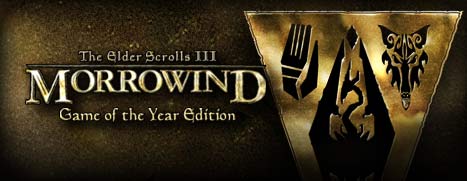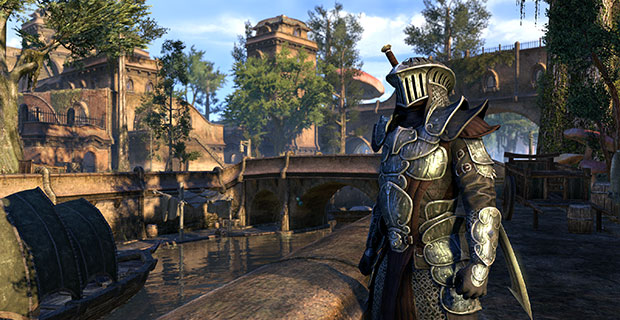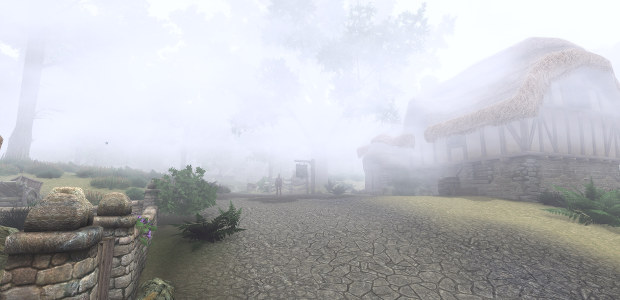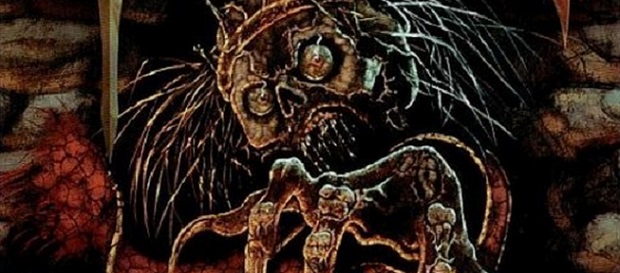
We've republished this feature in celebration of Morrowind's 15th birthday.
Vvardenfell is about half the size of Manhattan. You do laps around the island for hours, picking up incidental sidequests from the flawed populace holding on to their lives in musty townships like Balmora and Vivec City. This was a big deal in 2002. The Elder Scrolls toyed with open worlds before in the roughly 62,000 square mile procedural generation of 1996’s Daggerfall, but this was the first time Bethesda packed 100 hours worth of handmade design onto a beaming landmass and set the player free as soon as they stepped through the harbor. It might look quaint from the vast Imperial drama of Oblivion, or the treacherous hikes and dense hamlets of Skyrim, or, hell, the fully realized continent from The Elder Scrolls Online, but it was Morrowind where a generation first got their taste for the studio’s distinct, freewheeling fantasy.
It has been said that everyone’s favorite Bethesda game is the first one they play, as if stepping into that freedom for the first time is far more powerful and resonant than any prospective gameplay upgrades or graphical bumps. There’s probably no better proof than the community at Tamriel Rebuilt—a mod that’s been in development since Morrowind’s original release date.
According to legend, The Elder Scrolls III originally intended to include the complete Morrowind province, similar to Oblivion’s Cyrodiil and Fallout 3’s D.C. metro area. Limitations of processing power (and a desire to not rely on randomly-generated content) forced Bethesda to limit their scope to the gloomy island of Vvardenfell. Those scrapped plans were an enormous tease for players who fell in love with the island, so a fraction of the community took it upon themselves to complete that original, ambitious vision. 15 years later, it’s still not finished, and a group of amateur developers are still cooking up textures, models, and characters, stretching out the country a little bit further.
Joachim Haimburger started on Tamriel Rebuilt in 2005 at the tender age of 15. Today he heads the mod as a lead designer while studying to be a construction draftsman. This project has been a major part of his life for over a decade.
"I must admit I don't know the exact date [when Tamriel Rebuilt started]; I don't think anyone active in the project now does," he says. "None of the project's original members are still active, and quite a few of the current active members joined within the last two or three years. I think the main reasons people work on Tamriel Rebuilt are due to being inspired by the impressive work done by those who came before them and simply enjoying the process of working on the project."
That’s a sentiment echoed by a lot of people involved with Tamriel Rebuilt. The mod has taken on a mythic quality. When you step through the community’s incarnation of Morrowind, you’re traversing ground that was implemented by a legion of forerunners who were just as obsessed with this game as you.
"It's pretty cool to see where we came from. I do remember following the various releases of Tamriel Rebuilt and being interested in the project years ago, but naturally to me a lot of the stuff made before 2014 or so is "the old part of the mod" and the newer stuff is more personal because I actually worked on it," says Lauren, a modder who’s been actively working on Tamriel Rebuilt since the spring of 2015. "People usually ask, ‘when will you be done?’ and we don't have an answer for it, but we already made and released—in a completely playable state—so much. Our released content is the same size as Vvardenfell! That's nuts."
Work is usually assigned in a weekly meeting on Discord. The community settles on a major implementation project—like the overall look and aesthetic of a new area—and the diligent workforce stakes their claim of what they’d like to work on in the forums. If you page through Tamriel Rebuilt’s massive, sprawling "Asset Browser" subforum, you’ll find reams of doodads, NPCs, sound effects, and prospective quests authored by specific members of the labor pool. Lauren tells me that the assignment process is straightforward, because most people attach themselves to something that stokes their passion.
My favorite example might be the fan-penned literature for the incidental books you find stashed across a Bethesda continent. Tamriel Rebuilt intends to fill in the blanks of Morrowind as honorably and dutifully as they can, so of course there will be the Mysteries of the Worm.
Obviously generating a ton of original assets for a constantly-expanding universe like Tamriel Rebuilt isn’t easy, but everyone I spoke to involved with the project maintained that they don’t borrow content from other games—though they do share work with other The Elder Scrolls expansion mods. Part of that comes down to copyright claims.
"Bethesda historically has really frowned even on using assets developed for one of their games in another," says Atrayonis, a lead developer who’s been around the mod since 2005.
But you also get the sense that a blatant, easy plundering would double-cross this project’s soul. Why take a shortcut when it’s been in the oven for over a decade? Nobody involved with Tamriel Rebuilt is thinking about a release date. This project is a religion, and the rapture is far away.
"Tamriel Rebuilt is a volunteer project and work progresses only as fast as the available hands can do it. It takes a while for things to get made simply because there aren't so many of us actively working," says Lauren. "As well, technology marches on, and so many of the things that were done back in 2004 and such will at some point in the distant future get some more polish, once we're finished making the rest of the mainland, of course. So long as there's some of us around, we'll try to keep updating and polishing things."
The 'real' Morrowind
For a long time a major part of Tamriel Rebuilt’s appeal rested in the fact that it was the only way you could experience the Morrowind mainland in a game. That started to change in 2014, with the release of The Elder Scrolls Online and its patchwork implementation of some of the province’s more notable locales. On June 6th, Zenimax Online will release The Elder Scrolls Online: Morrowind, an expansion that will introduce the island of Vvardenfell to the world—unleashing a hungry playerbase into a 1080p incarnation of the redwood-tall mushroom stalks and fire plumes they first explored 15 years ago.
I played and enjoyed Oblivion and occasionally still play Skyrim, but basically neither game had the same depth of culture and environment. That feeling of exploring an unknown world was gone.
Tamriel Rebuilt modder Lauren
It seems strange to commit so much effort on a mod when Bethesda themselves are doing the work. Is there really so much to gain in building Morrowind when Skyrim, Cyrodiil, and whatever’s next is waiting? The members of Tamriel Rebuilt have never pondered that question, because to them, that 2002 version of Vvardenfell represents a Bethesda that doesn’t exist anymore.
"I played and enjoyed Oblivion and occasionally still play Skyrim, but basically neither game had the same depth of culture and environment. Not once did I feel like I was exploring an alien world in either game," says Lauren. "Naturally, those two games run better because the engine's been updated, and naturally they come with gameplay improvements too. But that feeling of exploring an unknown world was gone."
She’s not wrong. It’s funny how a generation recognizes The Elder Scrolls by its subdued European fantasy. Tall, gleaming castles, regal elven ruins, a player-character with the power to speak dragon. In Morrowind, a meteor called the "Ministry of Truth" hangs over Vivec City, which the populace repurposed as a jail for dangerous criminals. Bethesda still occasionally touches on that strangeness—the Shivering Isles and the twisted Daedra keeps come to mind—but generally, that side of The Elder Scrolls is treated like apocrypha, the part of the universe reserved for DLC.
"Personally I don't really consider our version of Morrowind more authentic than Elder Scrolls Online, just more authentic to the version of Morrowind Bethesda was trying to portray in The Elder Scrolls III," says Haimburger. "Bethesda has made significant changes in how it has presented Tamriel and its denizens between all of its games, and I don't really see that as a bad thing. I liked The Elder Scrolls III’s Morrowind the most, but Bethesda's concept of what 'Morrowind' is changed during the course of that game's production, and was different before then, and changed afterwards. Putting it optimistically, Bethesda's approach lets people pick what interpretation they like best, and I hope Bethesda comes up with an ever better interpretation later down the line."
On the Tamriel Rebuilt website, you can find an entire section dedicated to how their interpretation of Elder Scrolls lore has diverged from the mainline games. It’s winding and pious, but also kind of beautiful. "The Elder Scrolls games, and with them the lore have moved on, in multiple directions, and Tamriel Rebuilt moved in their own unique direction as well," it reads. "Charitably, the projects are building on what we think made Morrowind great. Uncharitably, we are isolationist grognards stuck in their outdated playground."
They are holding onto their canon, their themes, and their tone. They are holding onto the moment they first fell in love with The Elder Scrolls. And they aren’t ever leaving.











